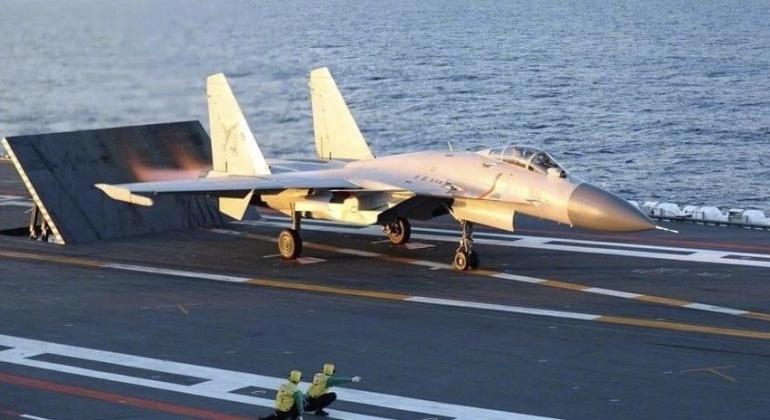News
China’s Top Aircraft Carrier Shandong Sets Record For Intensive Fighter Sorties: Drills Near Key American Guam Bases
The Chinese People’s Liberation Army (PLA) Navy’s second aircraft carrier the Shandong has been deployed for intensive drills across much of the Western Pacific, and after participating in a major simulated assault on Taiwan as a show of force against the United States and its local partners it has most recently begun operating near Guam in the Second Island Chain. The carrier was commissioned into service in 2019, and outside the U.S. Navy is a close contender for the title of the most capable in the world at over 60,000 tons and deploying 32 J-15 heavyweight fighter jets and various supporting helicopters and drones. The Shandong has been escorted on its latest mission by two destroyers, one each from the Type 055 and Type 052D classes and two Type 054A frigates, with a submarine escort considered likely but not confirmed. Two comprehensive replenishment ships of the Type 901 and Type 903 classes have also accompanied the strike group, allowing the carrier and surface combatants to remain at sea considerably longer despite expending considerable resources in exercises.

The Shandong’s exercises near Guam were interpreted by a number of analysts as a show of force aimed at the United States, which relies heavily on air and naval bases there to be able to maintain its large military presence in East Asia. Exercises near Guam have bene far from uncommon in the past at times of high tensions with the Untied States, a notable example being H-6 bombers’ rehearsal of strikes near the island in October 2017 as tensions peaked over the Korean Peninsula. China at the time sought to draw a red line against possible American attacks on its neighbour and treaty ally North Korea. North Korea itself simulated missile attacks on Guam at the time which was expected to be a primary target of tactical missile attacks should the U.S. launch a war. After the Shandong and Liaoning launched their first major joint exercises in the Pacific in December 2021, the Liaoning in May 2022 launched over 100 sorties near Okinawa – another leading hub of U.S. military activities. The Liaoning trained near Guam in some of its most recent far sea exercises in December 2022. Both ships’ conventional propulsion systems and lack of complex catapult launch systems have contributed to allowing them to spend considerable time at sea without the need for long maintenance periods or frequent overhauls, which partly explains why both ships can maintain a strong far sea presence near simultaneously.
The Shandong in the week from April 10 was estimated to have hosted approximately 210 aircraft sorties, 140 of which were for its J-15 fighters. This makes them the most intense far sea drills ever carried out by a Chinese carrier, surpassing the Liaoning’s January record of 320 sorties in over 15 days. Both Chinese carriers began to carry out far more intensive far sea exercises from 2021, after official sources highlighted in May that year that this would-be the case. Pilots began to train intensively for nighttime operations from that year as well. Although China only currently fields two carriers with fixed wing aircraft, both have demonstrated very high levels of combat readiness and the ability to launch sorties very intensively, with this experience expected to be valuable as the fleet grows and begins to integrate larger more advanced classes of ships. The country’s third carrier the Fujian is of an entirely different class, and is a supercarrier with a flat deck, catapult launch system and the ability to deploy close to twice as many fighters as well as a much wider range of support aircraft including airborne early warning and control platforms like the KJ-600. Its ability to launch and recover several aircraft simultaneously is expected to facilitate far more intensive drills than the Liaoning or Shandong are capable of. The Fujian has no peer level rivals abroad other than the U.S. Navy’s Gerald Ford Class supercarriers.

The Shandong, its predecessor the Liaoning, as well as the Fujian, are all conventionally powered ships well suited to China’s strong focus on security in the Western Pacific region and in particular countering Western countries’ power projection efforts into East Asia, for which the added range of nuclear powered ships is not seen as necessary. Nevertheless it has been speculated that an even larger class of carrier could be laid down later in the decade and integrate nuclear propulsion systems for out of area operations – including supporting allies and safeguarding trade routes. This could be seen as particularly necessary as calls in U.S. and among its Western allies grow for attacks on China’s global merchant shipping presence, by far the largest in the world, to be considered as a viable option in wartime. This would hardly be without precedent, with Iran, North Korea and Russia all having seen their merchant shipping targeted in international waters by Western warships and suffering due to their lack of a global naval presence. Laying down a nuclear powered carrier would coincide with the PLA Air Force’s expected initial acquisitions of its first intercontinental range bombers, the H-20s, which will be capable of extended operations beyond East Asia.












